How to grow Pudovik tomato for greater yield
The Pudovik tomato has established itself as an ideal variety for beginners. It is undemanding and unpretentious, but at the same time brings a large harvest with high taste characteristics. It is grown in all regions of Russia, both in open ground and in greenhouses.
Characteristics and description of the tomato variety
Pudovik is semi-determinate plant type. It grows in open ground up to 100-120 cm, and in a greenhouse higher: up to 170-180 cm.
The variety is quite spreading, per 1 sq. m plant no more than 3-4 bushes. The number of leaves is average, they are dark green in color, and the shape of the tomatoes is normal. The crop requires tying to a support and removal of stepsons.
Pudovik ripens in an average time. From planting seeds to receiving the first harvest of tomatoes, 110-115 days pass. The crop bears fruit for a long time. The bush shows the best result when formed into 2-3 stems and when planted in open ground. When grown in greenhouse conditions, the yield drops slightly.
Up to 5 kg can be harvested from one bush, respectively, if four plants are planted per 1 square meter. m, the crop will yield up to 20 kg of yield.
Tomatoes respond very well to the nutritional value of the soil and timely fertilizing. If the shoots are large, then the fruits will be large and in significant quantities.
The tomato has proven itself well in all “fields” of the Russian Federation. The crop is grown even in cold regions, and this hardened variety was developed by Siberian breeders.
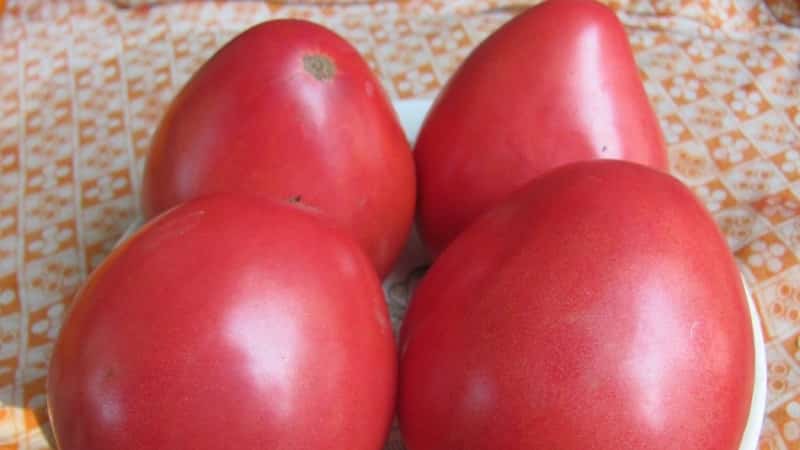
Advantages and disadvantages
The Pudovik variety is preferred by many gardeners to grow, as it has the following advantages:
- excellent taste;
- resistant to diseases;
- growing tomatoes in any environment;
- fruits are well preserved during transportation;
- high productivity and long fruiting;
- tomatoes are unpretentious to growing conditions and do not require special care;
- versatility of use: preparing various dishes, conservation etc.
The disadvantages of the variety include:
- bushes need to be tied up and pinched;
- if the crop grows in conditions of high humidity, the fruits may crack.
This variety does not have any significant disadvantages, which is why more and more people are growing Pudovik in their garden plots.
How to grow
Pudovik seeds are sown for seedlings from late February to March in nutritious and universal soil. In order for the plant to grow stronger and gain strength, it needs at least 70 days before picking. Shoots appear within a week after sowing in pre-prepared soil.
Growing seedlings
When two true leaves appear, the plants are transplanted into individual containers. In order for the seedlings to stretch, the best place for their growth will be a bright, southern window. The optimal temperature during the day is no higher than 20°C, and at night – no more than 16°C. Such conditions will make the seedlings compact.
To prevent it from outgrowing, various techniques and technologies are used:
- lower the temperature and increase the light;
- trim the root system;
- treat with a growth reduction drug.
On a note. The plant is transplanted into open ground when return frosts no longer occur.The “age” of the seedlings by this time should be at least 60-70 days.
Transplantation into the ground
Any place for replanting the plant is not suitable. The site must meet the following indicators:
- the predecessors of the crop should not be nightshades;
- It is better to choose a soil that is light and breathable;
- the place must be protected from strong winds;
- be sunny;
- without stagnation of moisture.
If the plant was grown in individual containers, then picking is not difficult. Carefully, without damaging the roots, remove the seedlings along with the soil from the cups and place them in the soil (in pre-made holes) up to the leaves.
If the seedlings are too elongated, which often happens with tall varieties, they can be planted lying down or the stem bent.
On a note. Before planting seedlings in the ground, it is recommended not to water the plant so that it is more pliable, and after planting, the sprouts will begin to absorb moisture and grow roots from the shoot sites, which will be sprinkled with soil.
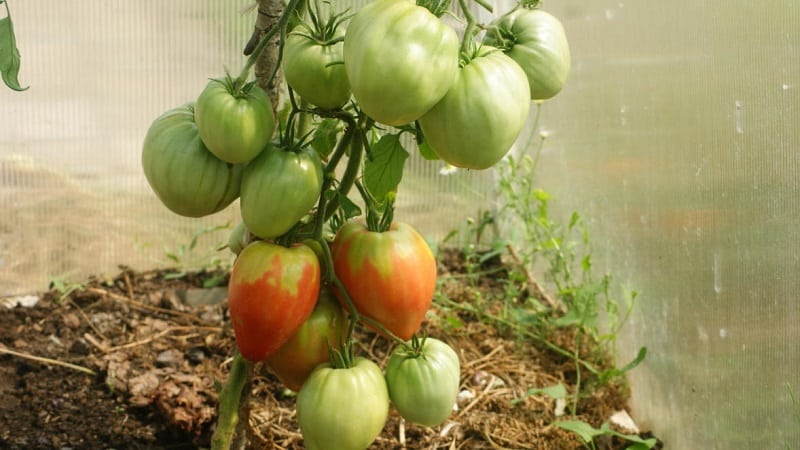
Care
The crop does not require special care, but for a large-fruited and high-yielding variety to show its full potential, it needs fertile soil and root feeding.
Watering Tomatoes should be produced regularly, but in moderation. Do not over-moisten the soil, otherwise waterlogging will damage the root system. The culture is moistened once a week, and in hot and dry weather - twice. Watering is carried out under the stem, 4-5 liters of water per bush, for these purposes it is better to infuse it with weeds, manure or compost. Rainwater also works well.
Water the plant in the evening, avoiding getting it on the leaves, as this can cause disease for the crop.
Important! You can find out whether Pudovik has enough moisture by its appearance: if it needs moisture, the leaves become dark and begin to fade.
Both in open ground and in a greenhouse, it is possible to irrigate tomato beds. For example, tomatoes are planted in two rows. Grooves are made for water (two on the side of each plant and one between them). The hose runs along the grooves. If each groove is filled with water, watering is considered sufficient.
Feeding and bush formation
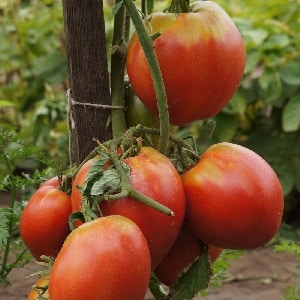 Tomatoes planted in open ground are fertilized every 15 days. The culture needs nitrogen, potassium and phosphorus. Fertilizing is applied comprehensively, but if you overdo it, the fruits may crack.
Tomatoes planted in open ground are fertilized every 15 days. The culture needs nitrogen, potassium and phosphorus. Fertilizing is applied comprehensively, but if you overdo it, the fruits may crack.
Pudovik belongs to the tall varieties of tomatoes. This feature requires the formation of a bush. The crop must be pinched, that is, the side shoots that develop in the leaf axils must be removed. The procedure relieves the bush of stress and promotes high-quality fruit development.
The plant also needs to be tied up, as its stems can sag under the weight of the fruit. Next to the bushes, pegs are driven into the ground, to which the plants are tied with twine or nylon rope; it is important to ensure that the garter does not crush the stem.
Soil care
This is a mandatory stage in growing not only Pudovik, but also other crops. The main enemy of fertile soil is parasitic plants, which not only “rob” the planted tomato, taking away all its nutrients and moisture, but can also become a breeding ground for insect pests. Soil care involves removing weeds and systematically loosening.
Mulching and hilling
When transplanting seedlings into a garden bed, experienced gardeners recommend mulching and hilling. The main stem is buried in soil to the level of the first leaves. This promotes the appearance of new small roots, with the help of which the plant will take root faster in new conditions.
Mulching is done in hot weather - this prevents the rapid evaporation of moisture from the soil, and steam does not reach the plant, which can cause it to become susceptible to disease.
You can use nettles, straw, weed clippings and tree bark as mulch. The main thing is that the mulch is healthy. If, along with it, the plants on the plantation are exposed to pests, then in conditions of high humidity they will multiply instantly.
Thanks to its characteristics, the Pudovik tomato has become popular among consumers. It is valued for its high yield, large fruits and excellent taste.
Prevention of diseases and pests
Pudovik is resistant to diseases and pests. To avoid troubles when growing crops, sometimes it is enough to carry out preventive treatment of plants with special means.
But still, despite their resistance, tomatoes can be susceptible to the following diseases and pests:
- mosaic;
- late blight;
- in greenhouse conditions, brown spotting may form;
- wireworms;
- caterpillars;
- Colorado beetle;
- spider mite
Almost all varieties of tomatoes are susceptible to this, so the means of combating them are no different. Still, it would be better to take care of the culture in advance and carry out preventive treatment. For this procedure, use “Polycarbacin”, “Fitosporin” or a solution of potassium permanganate.
On a note. Insecticides help control pests that attack tomatoes. They can be replaced with folk remedies, for example, infusion of garlic, hot pepper or wormwood.
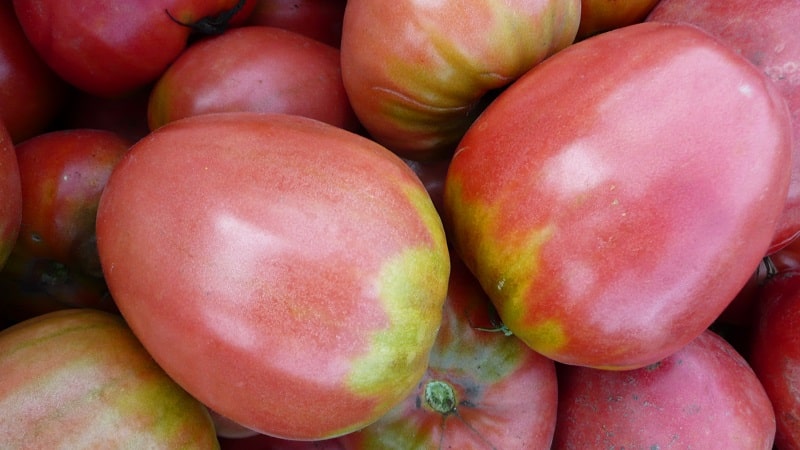
Reviews from gardeners
The tomato Pudovik (Sevruga) has gained wide popularity among gardeners. Positive reviews are left by both amateur summer residents and professional farmers.
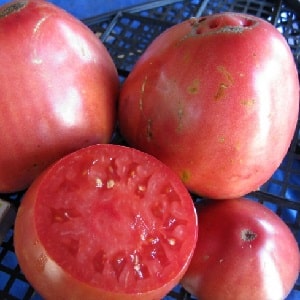 Galina Vladimirovna: “I love my garden and have been farming for a long time. I update tomato varieties regularly, but I have favorites that I grow with great pleasure for several years in a row. Among them is the Pudovik variety. These tomatoes grow very tasty, large in size, and almost ideal in shape. They transport well and can be stored for a long time. Just a farmer's dream."
Galina Vladimirovna: “I love my garden and have been farming for a long time. I update tomato varieties regularly, but I have favorites that I grow with great pleasure for several years in a row. Among them is the Pudovik variety. These tomatoes grow very tasty, large in size, and almost ideal in shape. They transport well and can be stored for a long time. Just a farmer's dream."
Ekaterina Viktorovna: “My family and I have lived in the village for quite a long time and grow tomatoes for ourselves all the time. From time to time I experiment and change varieties. Once I bought a Siberian tomato, Pudovik, in a store. I grew the seedlings, planted them, then cared for them as standard. I was so pleasantly surprised when I started harvesting. Unlike other varieties, these tomatoes were large, and also tasty and juicy. Of course, we couldn’t put them all into jars, but we prepared the juice for the winter and ate it fresh for a very long time.”
Alexander Yurievich: “I specifically chose a large variety of tomatoes for cultivation. We make little preparations; we mainly use the harvest fresh, which is why I chose Pudovik. The tomatoes grew the same as in the photo from the packaging, the family appreciated them. True, the grandchildren were given food only in salads. Children are too small to hold such large fruits in their hands, and they won’t be able to eat them whole. Excess tomatoes were used to make adjika and ketchup.I admit that the taste of this variety pleased me; I had never grown anything like it before. I will definitely plant Pudovik in the coming seasons.”
Conclusion
The characteristics and features of the Pudovik variety make this tomato universal: it can be grown in any part of our country. Regular implementation of simple agricultural practices will allow you to get a good harvest. This is proven year after year by the reviews of those who planted Pudovik in their garden plot. And getting up to 20 kg of large and juicy fruits from every square meter is the real dream of every vegetable grower!